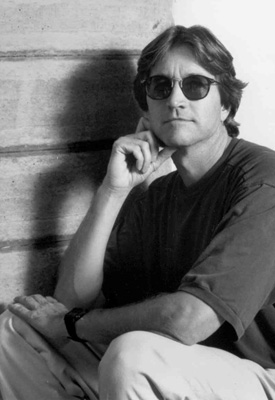Ron Fricke, 70mm film maker |
This article first appeared in |
| Written by: Material supplied by Ron Fricke | Issue 39 - June 1995 |
 Director
& Cinematographer, Ron Fricke. Publicity still by Magidson Films, 1992.
Image by: Rita Haft Director
& Cinematographer, Ron Fricke. Publicity still by Magidson Films, 1992.
Image by: Rita HaftRon Fricke ia a meticulous filmmaker who has mastered a wide range of skills. This versatility allows him to carefully sculpt his films during each phase of their development. He immerses himself completely in every stage of production, wrestling with the broad philosophical concepts that underlie his films, designing sophisticated equipment, framing each shot as if it were a painting, editing and color timing the finished print. In his early work as director of photography, co-editor and co-writer for "Koyaanisqatsi", a renowned nonverbal artfilm, Fricke experimented with many previously obscure film techniques. He used time-lapse, slow motion and optical phase printing to present familiar images from a new perspective. "Koyaanisqatsi" won a 1983 Filex Audience Award. Indulging his passion for 70mm, and determined to make life affirming films, Fricke proceeded to direct and co-produce "Chronos", an innovative, non verbal, IMAX film that won the Grand prix du jury Award at the first Festival International Omnimax de Paris (1987). For "Chronos" Fricke designed an IMAX compatible camera with the capacity to shoot motion controlled images, a revolutionary concept in the IMAX industry. Fricke gained experience on several other IMAX films including "Sacred Site" (1986) which he directed and photographed. "Baraka", Frickes latest creation, is a non-verbal feature film photographed in (65mm) 70mm in over 20 countries. It develops the themes of interconnection and transcendence, which Fricke began to explore in "Chronos", ""Baraka" is a journey of rediscovery that plunges into nature, into history, into the human spirit and finally into the realm of the infinite". In order to capture the exquisite rotating star fields in the film's finale, Fricke designed and built a more flexible and complex version of the (65mm) 70mm time-lapse camera he designed for "Chronos". Fricke directed, photographed, co-edited and co-wrote "Baraka" (1992). "Samsara" will be a visual quest that explores the cycle of birth, death and rebirth. "I feel that my work has evolved through "Koyaanisqatsi", "Chronos" and "Baraka", says Fricke. "Both technically and philosophically I am ready to delve even deeper into my favorite theme: humanity's relationship to the eternal". |
Further
in 70mm reading: |
|
Go:
back
- top
-
back issues Updated 22-01-25 |
